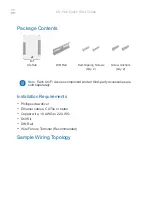
7.4.3
Interrupt Handling
Access conflicts may occur when reading and writing data simultaneously at the two independent ports of the Frame
Buffer, TX/RX BBP and SPI. These ports have their own address counter that points to the Frame Buffer’s current
address.
Access violations may cause data corruption and are indicated by IRQ_6 (TRX_UR) interrupt when using the Frame
Buffer access mode. Note that access violations are not indicated when using the SRAM access mode.
While receiving a frame, first the data need to be stored in the Frame Buffer before reading it. This can be ensured
by accessing the Frame Buffer at least eight symbols (BPSK) or two symbols (O-QPSK) after interrupt IRQ_2
(RX_START). When reading the frame data continuously, the SPI data rate shall be lower than the current TRX bit
rate to ensure no underrun interrupt occurs. To avoid access conflicts and to simplify the Frame Buffer read access,
Frame Buffer Empty indication may be used.
When writing data to the Frame Buffer during frame transmission, the SPI data rate shall be higher than the PHY
data rate avoiding underrun. The first byte of the PSDU data must be available in the Frame Buffer before SFD
transmission is complete, which takes 41 symbol periods for BPSK (one symbol PA ramp up + 40 symbols SHR) and
11 symbol periods for O-QPSK (one symbol PA ramp up + 10 symbols SHR) from the rising edge of pin 11 (SLP_TR).
Notes:
1.
Interrupt IRQ_6 (TRX_UR) is valid two octets after IRQ_2 (RX_START).
2.
If a Frame Buffer read access is not finished until a new frame is received, an IRQ_6 (TRX_UR) interrupt
occurs. Nevertheless the old frame data can be read, if the SPI data rate is higher than the effective PHY data
rate. A minimum SPI clock rate of 1MHz is recommended in this case. Finally, the microcontroller checks the
integrity of the transferred frame data by calculating the FCS.
3.
When writing data to the Frame Buffer during frame transmission, the SPI data rate shall be higher than the
PHY data rate to ensure no under run interrupt. The first byte of the PSDU data must be available in the
Frame Buffer before SFD transmission is complete.
7.5
Crystal Oscillator (XOSC) and Clock Output (CLKM)
The main crystal oscillator features are:
• 16 MHz amplitude-controlled crystal oscillator
• Fast settling time after leaving SLEEP state
• Configurable trimming capacitance array
• Configurable clock output (CLKM)
7.5.1
Overview
The internal 16 MHz crystal oscillator to the module generates the reference frequency for the AT86RF212B. All other
internally generated frequencies of the radio transceiver are derived from this frequency. The XOSC_CTRL register
provides access to the control signals of the oscillator.
7.5.2
Integrated Oscillator Setup
Using the internal oscillator, the oscillation frequency depends on the load capacitance between the crystal pin 2
(XTAL1) and pin 1 (XTAL2) of ATSAMR30E18A. The total load capacitance C
L
must be equal to the specified load
capacitance of the crystal itself. It consists of the internal capacitors CX and parasitic capacitances connected to the
XTAL nodes inside the module.
The figure below shows all parasitic capacitances, such as PCB stray capacitances and the pin input capacitance,
summarized to C
PAR
.
ATSAMR30M18A
Module Description
©
2018-2021 Microchip Technology Inc.
and its subsidiaries
Datasheet
DS70005384B-page 25
















































